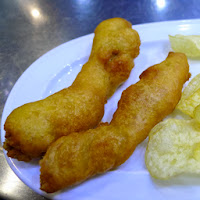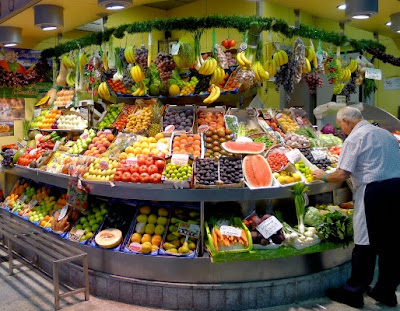 |
| Bar Las Teresas |
From hot Sevilla streets, into the cool interior of
Bar Las Teresas. Within minutes, we have
copas of chilled white wine, a plate of sliced ham and a bowl of Sevilla olives. I have arrived. I’m about to begin a three-day intensive, immersion course in
ANDALUSIAN TAPAS.
 |
| First tapa--ibérico ham. |
Sevilla is “Eden” in the tapas “creation story.” Tapas originated In the bars and bodegas of this Andalusian city. From here, tapas evolved (and, continue evolving), and spread throughout Spain
By day, I’m taking in tastes and insights at
Andalucía Sabor, a food fair and gastronomy conference featuring Andalusia’s best chefs. Theme this year:
La Tapa. Tradición e Innovación en la Cocina Andaluza (The Tapa—Tradition and Innovation in Andalusian Cuisine).
Outside the congreso, I’m pursuing my tapas research in the bars and tabernas of Sevilla. I’ve got a personal trainer, my guide to tapas in Sevilla. She is
Shawn Hennessey, a Canadian who has been living in Sevilla for more than 20 years. Back when she was still teaching English, Shawn happily took friends and friends of friends around to her favorite tapa bars. After a serious illness, she made some changes in her life, gave up teaching and turned “pro”—she now is a “tapas tour guide”, known everywhere in Sevilla. (Get in touch with Shawn at azahar.sevilla@gmail.com and check out her running reviews of tapa bars at
http://seville-tapas.com )
Bar Las Teresas is tucked in a side street (C/Santa Teresa 2), right in the Barrio Santa Cruz, Sevilla’s tourist heartland. Shawn used to live in this barrio, very near the big cathedral plaza, where she could see the Giralda from her balcony. “I still feel at home in this bar,” says Shawn.
Back on the street, we make a stop at one of my old favorites,
Bar Modesto, (C/Cano y Cueto, 5) (I love their
chocos con habas, cuttlefish with fava beans in inky sauce), then continue to nearby
Vinería San Telmo (Paseo Catalina de Ribera, 4), a modern wine bar run by an Argentine, Juan Manuel Tarquini.
 |
| With Shawn at Vinería San Telmo. |
Shawn and I share tapas here—
morcilla de Burgos (blood sausage flecked with rice—Shawn named her kitten “Morcilla de Burgos” for its coloring) in a smooth red pepper sauce and grilled
pluma, a cut of ibérico pork, with yucca chips. We chat with Juan, take photos of each other and tweet them. Shawn, a Twitter master (@SevillaTapas), shares her every tapa bite on Twitter. She opened an account for me (@Janet_Mendel), but without a smartphone, tweeting while out and about is limited.
Mid-September and it’s still hot in Sevilla, so sipping chilled white wine is a pleasure. The Vinería offers an astonishing selection of wines by the glass, including Shawn’s choice, Botani, a fresh and floral white made in Málaga (
http://www.jorgeordonez.es/nuestros-vinos/botani/ ).
It’s a Sunday evening, and the streets are pretty quiet in Sevilla. Nevertheless, folks are out for a stroll, a
copa and a tapa.
The following evening, an ordinary Monday, the bars and cafés are really buzzing. Shawn takes me first to an
abacería, a small grocer’s shop specializing in cheeses, cured meats and canned foods.
 |
| Bar at abacería Casa Moreno. |
The señora at
Casa Moreno (C/Gamazo,7) tends the tiny store and her husband presides at a small, backroom bar. “It took me almost 18 years to finally go into this place,” Shawn says. “I’d walked in a couple of times, but it felt so intimate and so SPANISH – like I had stepped through a portal to the 1940s – that I felt too obviously a
guiri (foreigner) to comfortably stay. But, from the first time I sat at the end of the crowded bar, I was made to feel right at home.”
We share
montaditos, small grilled sandwiches, of Cabrales blue cheese and of
pringá, a meat and sausage mash. “The best pringá is at Bodeguita,” Shawn claims. “You have to try it there.”
I ask Shawn how she organizes her tapas tours. “Depends on the people and how long they are staying,” she replies. She recommends at least a three-night stay in Sevilla, with the tapas tour on the first night.
“I take visitors to places where they probably wouldn’t walk in on their own. They get a feel for the tapas experience, see how to order and feel more confident on their own. Even if they don’t like something, they’re like, ‘oh, that only cost €3.’ They get to know Spanish food.”
 |
| Salpicón with shellfish and avocado, Enrique Becerra. |
As we perch on bar stools at Bar-Restaurante
Enrique Becerra (C/Gamazo 2, in the Arenal district), eating a delicious tapa of
mollejas, lamb sweetbreads, Shawn continues. “I get my visitors to taste stuff they might not know even existed. No tripe. No tongue. Octopus if they seem open to it. I always get them eating
morcilla (blood sausage).”
By this point, I am starting to crave salad, so we order a tapa of
salpicón, chopped tomatoes, onions and peppers with shellfish. This is a luxury version, with slices of avocado. Both tapas at Becerra cost under €3.50. In most tapa bars, the price of tapas is less if you stand or sit at the bar than if you sit at a table.(For some recipes from Enrique Becerra, see this
blog post from 2011.)
 |
| Grilled tuna belly at La Azotea |
At our next stop, seated at the bar at
La Azotea (C/Zaragoza 5) we share a single tapa, a plate of soy-marinated
ventresca, tuna belly. It costs only €4 and is a generous serving, absolutely delicious. A basket of bread comes free at the bar, but costs additional if you sit at a table.
This is one of Shawn’s rants—the odious bread fee that some bars tack on. Her take is that bread is essential with tapas and should always be served. Bars should factor in the cost and up the price of the tapa, rather than charge additional for bread.
Some might call La Azotea a “gastrobar,” but Shawn resists that word. “When I call a place a ‘gastrobar,’ I'm not being nice. I refer to rip-off trendy joints as ‘gastrobars.’ I would call La Azotea either a ‘gourmet tapas bar’ or ‘innovative’.”
On her tours, Shawn usually takes clients to three different bars to mix it up a bit. She starts them at a traditional type of bar to sample Spanish ham and cheeses with Sherry, then continues to a friendly, family-run bar for some classic tapas, and finishes at a modern bar that’s young and buzzy. “I don’t go to chains,” she says. “Just bars that belong to somebody. Usually I know the owners.” And, although she is always on the lookout for the new and good, she avoids taking visitors to bars that “opened day before yesterday.”
Shawn charges an all-inclusive price per person for the tour—three bars, two drinks and two tapas in each (consult Shawn for prices), but can customize tours to suit clients. Specialty tours include market tour, flamenco and tapas, Sherry tasting.
 |
| Bar El Rinconcillo |
The next day we get back from the conference center in time for a late tapas lunch at
El Rinconcillo, not far from the neighborhood where Shawn lives. El Rinconcillo, founded in 1670, claims to be Sevilla’s oldest tapas bar. Colorful Sevilla tiles cover the facade and interior walls. Hams hang from the rafters. The barman chalks your bill on the wooden bar.
 |
| Fried hake at El Rinconcillo. |
The
espinacas con garbanzos, spinach and chickpeas, are classic—plenty of garlic and cumin. The batter-fried hake is crisp on the outside, flaky and moist within. A small heap of cole slaw is the perfect garnish. Slaw, Sevilla style, is made with lightly cooked cabbage dressed with olive oil and vinegar, no mayo. It's still crunchy, but not raw. Elsewhere, I've had it garnished with pomegranate seeds.
Can you make a meal on just tapas? Absolutely. In Sevilla, the portions are generous and they come with bread and/or bread sticks. Not quite enough to fill you up? Have another tapa. Priced from €3 to €5, tapas add up to a bargain meal. This is different from where I live, on the Costa del Sol (Málaga), where a tapa might cost less, but is really just a bite. You would have to order a
media ración, half-plate, or
ración, full plate, to get the same portion size.
I have some leisure time to do some shopping (Zara Home, El Corte Inglés, are near where I’m staying) and enjoy a coffee in a café in the plaza before time to join Shawn for our last round of tapas.
We head straight for what is, possibly, her favorite tapas bar. She doesn't actually claim a favorite. But, at
Bodeguita Romero (C/Harinas 10) she feels at home. She knows everybody by name and they know her. And, the tapas are, arguably, the best in Sevilla.
 |
| Potatoes at Bodeguita Romero. |
Along with our drinks order (yes, we are still drinking white wine) comes a tapa of a house specialty,
papas aliñadas, potatoes with a simple oil-vinegar-parsley dressing, that Pedro Romero, third-generation to run the bar, makes daily. For something so simple, it is unbelievably good.
 |
| The best pringá at Bodeguita Romero. |
“Here,” declares Shawn, “is the best pringá.” Pringá is leftovers, the pork fat, meat and sausages from a midday
cocido, a one-pot-meal. They are mashed or chopped together and spread on a small toasted bun. The version at Bodeguita Romero is, as advertised, spectacular. It’s chunky, instead of a paste, and has more morcilla and little chorizo, which gives it a spicier flavor. Love it.
 |
| Pavía of salt cod |
I am wanting a traditional Sevilla tapa of
pavía, bacalao (salt cod) fried in a special batter. This version is spot-on. I ask Angela, Pedro’s wife, how she makes it. She says the batter has
levadura Royal—baking powder. Other versions, including the recipe in my book,
Tapas—A Bite of Spain, call for yeast.
 |
| Two señoras at Bodeguita Romero. |
Our other tapa,
carillada, pork cheeks, is one of those deeply satisfying dishes, “like your grandmother made,” says Shawn. I’ll have to go back to ask Angela for her recipe.
Wending our way back to our home barrio, we stop at another trendy new tapas bar,
La Brunilda (C/Galera 5; Arenal). Shawn has got to have her fix—a super-umami burger. She calls it “crack burger” because it’s so addictive. Juicy beef, a soy mayo, bun—hey, is this Sevilla? Are we still talking about tapas? Yes, indeed. tapas are open-ended, always expanding. I think I’m ready for the graduate seminar.





























